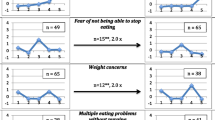Abstract
Objective: To estimate the late-adolescent population “at risk” for eating disorders (EDs), establish its stability over time using repeated measures, and analyse its social and demographic background factors. Method: The Eating Disorder Inventory (EDI) and a number of related questions were administered to students in their last year of high school in five Swedish towns in 1993 (n=3855) and 1998 (n=2925). Results: It was found that 6% of girls were “at risk” for eating disorders with no increase over time. There was an association between this risk and certain socio-demographic factors (living alone, moving away from home early, excessive physical training and experiences of bullying). No differences were found between cities of different size. Conclusion: A considerable proportion of girls in late adolescence are preoccupied with weight and dieting, and may be considered “at risk” for developing a clinical eating disorder. This proportion seems to be fairly stable over time.
Similar content being viewed by others
References
Slade P.: Prospects for prevention. In: Szmukler G., Dare C., Treasure J. (Eds.), Handbook of eating disorders: Theory, treatment and research. London, John Wiley & Sons, 1995, pp. 385–398.
Kostanski M., Gullone E.: Adolescent body image dissatisfaction: relationships with self-esteem, anxiety, and depression controlling for body mass. J. Child Psychol. Psychiatry, 39, 255–262, 1998.
Garner D.M., Olmsted M.P., Polivy J., Garfinkel P.E.: Comparison between weight-preoccupied women and anorexia nervosa. Psychosom. Med., 46, 255–266, 1984.
Patton G.C., Johnson-Sabine E., Wood K., Mann A.H., Wakeling A.: Abnormal eating attitudes in London schoolgirls in a prospective epidemiological study: outcome at twelve month follow-up. Psychol. Med., 20, 383–394, 1990.
Wood A., Waller G., Gowers S.: Predictors of eating psychopathology in adolescent girls. Eur. Eating Disord. Rev., 2, 6–13, 1994.
Calam R., Waller G.: Are eating and psychosocial characteristics in early teenage years useful predictors of eating characteristics in early adulthood? A 7-year longitudinal study. Int. J. Eating Disord., 24, 351–362, 1998.
Schleimer K.: Dieting in teenage schoolgirls. Acta Paediatr. Scand., (Suppl), 312, 1983.
Nylander I.: The feeling of being fat and dieting in a school population: Epidemiologic interview investigation. Acta Sociomed. Scand., 1, 17–26, 1971.
Beaumont P.J.V.: Defining subgroups of eating disorder patients by means of the Eating Disorders Examination. Br. J. Psychiatry, 166, 472–474, 1995.
Patton G.C.: The spectrum of eating disorders in adolescence. J. Psychosom. Res., 32, 579–584, 1988.
Garner D.M., Olmsted M.P., Garfinkel P.E.: Does anorexia nervosa occur on a continuum? Int. J. Eat. Disord., 2, 11–20, 1983.
Ghaderi A., Scott B.: Prevalence and psychological correlates of eating disorders among females aged 18-30 years in the general population. Acta Psychiatr. Scand., 99, 261–266, 1999.
Stein D., Meged S., Bar-Hanin T., Blank S., Elizur A., Weizman A.: Partial eating disorders in a community sample of female adolescents. J. Am. Acad. Child Adolesc. Psychiatry, 36, 1116–1123, 1997.
Cotrufo P., Barretta V., Monteleone P., Maj M.: Full-syndrome, partial-syndrome and subclinical eating disorders: An epidemiological study of female students in Southern Italy. Acta Psychiatr. Scand., 98, 112–115, 1998.
Dalle Grave R., De Luca L., Oliosi M.: Eating attitudes and prevalence of eating disorders: A survey in secondary schools in Lecce, southern Italy. Eating Weight Disord., 1, 34–37, 1997
Cooper P.J., Goodyer I.: Prevalence and significance of weight and shape concerns in girls aged 11–16 years. Br. J. Psychiatry, 171, 542–544, 1997.
Hooper M.S.H., Garner D.M.: Application of the Eating Disorders Inventory to a sample of black, white, and mixed race schoolgirls in Zimbabwe. Int. J. Eat. Disord., 5, 161–168, 1986.
Garner D.M., Olmsted M.P., Bohr Y., Garfinkel P.E.: The Eating Attitudes Test: Psychometric features and clinical correlates. Psychol. Med., 12, 871–878, 1982.
Garner D.M., Olmsted M.P.: Manual for Eating Disorder Inventory (EDI). Odessa. Psychological Assessment Resources, Inc., 1984.
Pawluck D.E., Gorey K.M.: Secular trends in the incidence of anorexia nervosa: Integrative review of population-based studies. Int. J. Eat. Disord., 23, 347–352, 1998.
Fombonne E.: Anorexia nervosa. No evidence of an increase. Br. J. Psychiatry, 166, 462–471, 1995.
Hsu L.K.G.: Epidemiology of the eating disorders. Psychiatr. Clin. North Am., 19, 681–700, 1996.
Norring C., Sohlberg S.: Eating Disorder Inventory in Sweden: description, cross-cultural comparison, and clinical utility. Acta Psychiatr. Scand., 78, 567–575, 1988.
Garner D.M.: Eating Disorder Inventory-2. Professional manual. Odessa, Psychological Assessment Resources, Inc., 1991.
Beglin S.J., Fairburn C.G.: Evaluation of a new instrument for the detection of eating disorders in community samples. Psychiatry Res., 44, 191–201, 1992.
Engström I., Hägglöf B., Lago C.: Personal communication, 2001.
Hoek H.W., Bartelds A.I.M., Bosveld J.J., van der Graaf Y., Limpens V.E., Maiwald M., Spaaij C.J.: Impact of urbanization on detection rates of eating disorders. Am. J. Psychiatry, 152, 1272–1278, 1995.
Author information
Authors and Affiliations
Rights and permissions
About this article
Cite this article
Engström, I., Norring, C. Estimation of the population “at risk” for eating disorders in a non-clinical Swedish sample: A repeated measure study. Eat Weight Disord 7, 45–52 (2002). https://doi.org/10.1007/BF03354429
Received:
Accepted:
Published:
Issue Date:
DOI: https://doi.org/10.1007/BF03354429




